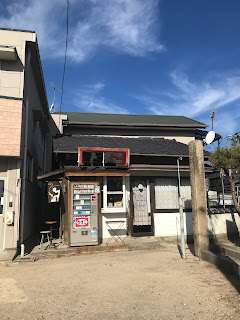Let me start with a few pictures from my recent Shodoshima album
before elaborating on the Georges Gallery.
 |
angel road in January 2022 near tonosho port
A sand bar appears at low tides
connecting three islands ahead
This is one of the typical seascapes
of Shodoshima |
 |
a view from Shiho-zashi observation point,
777 meters high
This is higher than the hilltop cable station area
and often shrouded with fog but with good luck
a mystic view appears
|
 |
| front of the Georges Gallery |
 |
| back of the gallery |
There are many places you shouldn't miss in Shodoshima. Therefore, I recommend you stay at least two nights. After all it's an island and you need to take some time to go there itself.
Shodoshima is the second largest island in the Seto Inland Sea and the whole area is called Setouchi. If you can drive and rent a car in Japan, it will be the easiest way to explore the island. If you are physically fit, you can rent a bike but should limit your cycling zone to effectively use your time. Bus services are available but not so frequent and you will need good planning.
Having said that, however, the Tonosho maze town area and Hishio-no-sato area where the gallery is located should be relatively easy to explore even if you do not have a car.
This time I'm writing on this art gallery and its art installations in Umaki, Hishio-no-sato where soy sauce manufactures stand close to each other.
The gallery and installations have been very popular since they were open to the public in 2018 on the occasion of the Setouchi International Art Festival which has been held every three years since 2010.
Without any further ado, here's what you see at the gallery. There are more to see of course; after all, the photographs were the final artworks of Georges Rousse. You have to see them. And the old house itself which has been beautifully resurrected.
What's more, their contemporary art museum and its annex preliminarily opened last year and the grand opening is coming this March. And their cafe is super good, I have to emphasize.
 |
installation of gold and brass leaf
SHODOSHIMA2018©︎GEORGE ROUSSE
|
The story of this gallery has to start with the devastation caused by the Great Hanshin-Awaji earthquake in 1995. When it happened, ISHII Jun was working for a big established company where he was assigned to the mecenat division. He thought there had to be something his company could do to support the affected areas with art.
He came across with photographer and artist Georges Rousse and invited him to Kobe where the artist was commissioned to eight artworks - the final works were photographs; the subjects of the photos were gone because Rousse makes geometric installations in the ruins or buildings doomed to be demolished and then takes their pictures before they are forever gone.
The photos taken in Kobe were eventually donated to an art museum in Kobe.
In case of Shodoshima, the installations made by Rousse remain and are open to the public. This is the only place in the world his installations can be seen permanently by the audience.
Rousse was invited by ISHII who wanted to revive his grandpa and grandma's house in Shodoshima. Rousse chose two sites in the house and a small humble warehouse, five-minutes-on-foot away from the house.
As a young kid, he was at the house on special occasions; in fact his parents held a wedding reception there; but the last resident, ISHI's grandma died and nobody lived there for 26 years. He wanted to revive the house where family memories were still felt but would be forgotten if the house was left alone.
He asked Rousse if he was interested in applying for the Setouchi International Art Festival and his answer was affirmative. He first came to the island in 2017 to check on the house and its vicinities and then came back in 2018 to make three installations and take photos.
He took the pictures and this time, accepted these installations should remain as they are.
Now they are amazing art installations, particularly the one in a Japanese-style room - the picture shown above. The pictures were taken, of course, but it's the remaining installations that have made ISHII's grandma's house breathe again. The memories have been conjured up and they are side by side with the visitors to the gallery living the present time.
The Setouchi International Art Festival 2022 will start in April and the gallery can be visited with the festival passport that you might purchase. But the gallery along with their contemporary museum/annex is permanent. You can go there before and after the festival.
PS
Goishi-zan mountain is nearby. Its view and the temple along with the temple monk there are hard to miss. You can ask him to perform a prayer ritual for your wish like healthy life by buying a small wooden slat where your wish is written - 500 yen. It's a fifty-minute walk and hike from the gallery.
Including this holy place, there are more than 88 pilgrimage places related to Kukai, the founder of Shingon school of Japanese esoteric Buddhism active in the 9th century. He's been loved as a cultural hero with compassion and was ubiquitous at multiple places at the same time - impossible but that's the way people believed due to their faith to him.
His temples are open to everybody and many, I feel, go with the present issues and are aligned with the time we live.
 |
| Immovable King at the edge of Goishi-zan |



















































